Pressure in Sinuses and Eyes: How Do Sinuses Affect Your Eyes?
How can a sinus infection affect your eyes? Learn about the eye symptoms of sinusitis, including eye pain, watery eyes, swollen eyes, vision problems, and serious complications like cellulitis and cavernous sinus thrombosis.
The Impact of Sinusitis on Eye Health
Sinusitis, an inflammation or infection of the sinuses, can have a significant impact on your eye health and vision. The proximity of the sinuses to the eyes means that sinus problems can easily translate into eye-related symptoms and complications. From mild discomfort to severe vision-threatening conditions, understanding how sinuses affect the eyes is crucial for maintaining optimal eye health.
Eye Symptoms of Sinusitis
A sinus infection can cause a range of eye-related symptoms, including:
- Eye pain or pain behind the eyes: This can feel like a headache or discomfort in the eye area.
- Eye watering (epiphora): Chronic sinus infections can lead to persistent watery eyes.
- Swollen eyes and eyelids: Inflammation in the sinuses can cause puffiness and swelling around the eyes.
- Blurry vision and vision loss: In rare cases, sinus problems can damage the optic nerve and lead to vision problems.
Sinus Infections and Eye Infections
In some instances, a sinus infection can spread to the eye area, leading to additional complications:

- Periorbital cellulitis: An infection in the skin and soft tissues around the eye, including the eyelid. This is more common in children.
- Orbital cellulitis: An infection in the tissues around the eyeball itself. This is a more serious condition that requires hospitalization and intravenous antibiotics.
It’s important to seek medical attention promptly if you suspect either of these eye infections, as they can have severe consequences if left untreated.
Rare Sinus Complications Affecting the Eyes
While uncommon, there are some more serious sinus-related complications that can affect the eyes:
- Cavernous sinus thrombosis: A rare but dangerous condition where a blood clot forms in the cavernous sinus, a structure that contains important arteries and nerves. Symptoms can include eye pain, swelling, vision problems, and even blindness.
- Bacterial meningitis: A life-threatening infection of the membranes surrounding the brain and spinal cord that can sometimes spread from the sinuses. Symptoms may include fever, headache, and eye-related issues.
Seeking prompt medical attention is crucial if you experience any of these severe sinus-related complications.
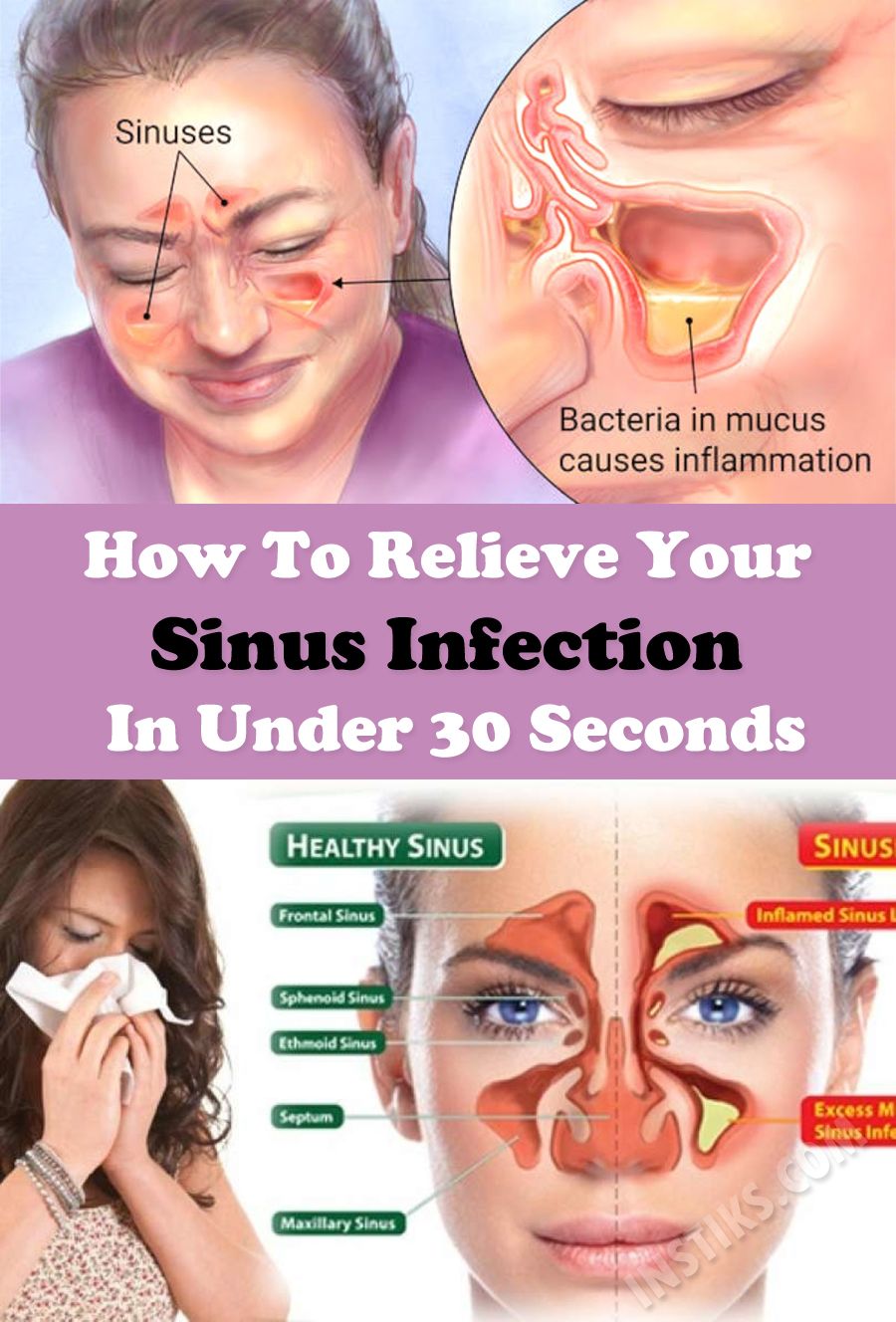
Preventing and Treating Sinus-Related Eye Problems
The best way to avoid eye-related complications from sinusitis is to properly manage your sinus health. This may include:
- Treating sinus infections promptly with medication as prescribed by your doctor
- Using saline nasal rinses to keep the sinuses clear
- Identifying and avoiding any environmental triggers for sinus flare-ups
- Seeking medical attention right away if you experience any new or worsening eye symptoms
By staying on top of your sinus health, you can help prevent the spread of infection to the eyes and maintain optimal eye function and vision.
The Importance of Prompt Medical Attention
If you are experiencing any eye-related symptoms that you suspect may be linked to a sinus infection, it’s crucial to seek medical attention right away. Delaying treatment can allow the condition to worsen and potentially lead to serious complications that could threaten your vision or even your overall health. Don’t hesitate to consult an eye doctor or your primary care provider if you have any concerns.

Conclusion
The close anatomical relationship between the sinuses and the eyes means that sinus problems can have a significant impact on eye health and function. From mild discomfort to severe vision-threatening conditions, understanding the potential eye-related complications of sinusitis is essential for maintaining optimal eye and overall health. By staying vigilant and seeking prompt medical attention when needed, you can help prevent and effectively manage any sinus-related eye issues.
How Do Sinuses Affect Your Eyes?
By Allie Johnson; reviewed by Sonia Kelley, OD, MS
Can a sinus infection affect your eyes?
A sinus infection (sinusitis) can cause pain around your eyes, eyelid swelling and other symptoms that can affect your vision. Get eye pain and vision changes checked out by an eye doctor as soon as possible to avoid vision loss and other eye health issues.
What is sinusitis?
Sinusitis is an inflammation or infection of the sinuses, which are hollow spaces near your eyes and nose. The sinuses make mucus, which drains out through your nose. Typically filled with air, sinuses that are blocked fill with fluid. This extra fluid promotes germ growth and the potential development of a viral, bacterial or fungal infection.
The maxillary sinuses (below your eyes) are most likely to get infected. A maxillary sinus infection may cause pain below the eyes and in the cheeks. You also have sinuses:
Between your eyes (ethmoidal)
Behind your eyes (sphenoidal)
Above your eyes (frontal)
Infected sinuses may cause you to experience the following symptoms:
A sinus infection may clear up in less than a month with treatment. However, some patients may develop chronic or recurring infections.
However, some patients may develop chronic or recurring infections.
Eye symptoms
In addition to eye pain or pain behind the eyes, there are other eye symptoms that may be caused by infection-related sinus pressure. These may include:
Eye pain – You may feel pain behind or around the eyes. This may feel like pain in your eyes or a headache behind your eyes.
Eye watering – A chronic infection can lead to watery eyes (epiphora). But these symptoms may also be caused by other conditions. A cold or allergies may cause eye watering and a feeling of stuffiness or pressure. A cluster headache can similarly cause pressure, watery eyes and a stuffy nose.
Swollen eyes – You may also experience eyelid swelling and eye puffiness. This can occur when the sinuses between and below your eyes become inflamed and clogged with mucus. The swelling typically goes away as your condition improves with treatment.

Sinus problems such as chronic sinusitis can also cause blurry vision, vision loss and other problems due to optic nerve damage caused by chronic inflammation, although this is rare.
SEE RELATED: Pressure behind the eye
Can you get a sinus infection in your eyes?
In some cases, a sinus infection can spread to the eyelid, skin and soft tissues.
Periorbital cellulitis, also known as preseptal cellulitis, can occur when the area around the eye, including the eyelid, becomes infected.
Orbital cellulitis can occur if the eyeball itself, and the tissues around the eyeball, become infected. Periorbital cellulitis cannot develop into orbital cellulitis because a fibrous tissue surrounding the eyeball serves as a barrier.
Both of these conditions are more common in children than in adults. Periorbital cellulitis is more common and less dangerous than orbital cellulitis. Both conditions can cause red, swollen and painful eyelids. Fever may sometimes occur with periorbital cellulitis, although it is more common in orbital cellulitis. It is important to note that periorbital cellulitis does not typically affect vision or eye movement.
Both conditions can cause red, swollen and painful eyelids. Fever may sometimes occur with periorbital cellulitis, although it is more common in orbital cellulitis. It is important to note that periorbital cellulitis does not typically affect vision or eye movement.
In addition to the symptoms above, symptoms of orbital cellulitis may include:
Fever
Malaise (general sense of being sick or uncomfortable)
Headache
A bulging eye (exophthalmos)
Blurry vision
Double vision
Eye pain, especially when moving the affected eye
You may be able to treat periorbital cellulitis at home with oral medications under close supervision of an ophthalmologist. Orbital cellulitis requires hospitalization and IV antibiotics. It is important to see a doctor right away if you think you or your child may have either condition.
Other sinusitis complications that can affect the eyes
There are other complications of infected sinuses that can affect your vision, though most are rare. It’s still a good idea to know about these problems so you can get medical care right away if necessary.
It’s still a good idea to know about these problems so you can get medical care right away if necessary.
Cavernous sinus thrombosis
Cavernous sinus thrombosis (CST) is a rare but dangerous condition. It usually starts in one eye and spreads to the other. The most common symptoms are fever and headache, which may appear along with eye issues.
Several eye-important arteries and nerves pass through the cavernous sinus, so damage to this area can result in a number of eye complications.
Symptoms of CST may include:
Pain around the eye
Swelling of the eyelids
Drooping eyelids (ptosis)
Double vision (diplopia)
Light sensitivity (photophobia)
Vision loss
Less common symptoms may include confusion, face numbness, a stiff neck or coma.
It’s crucial to seek treatment right away because CST can be life-threatening and may cause blindness in up to 15% of cases.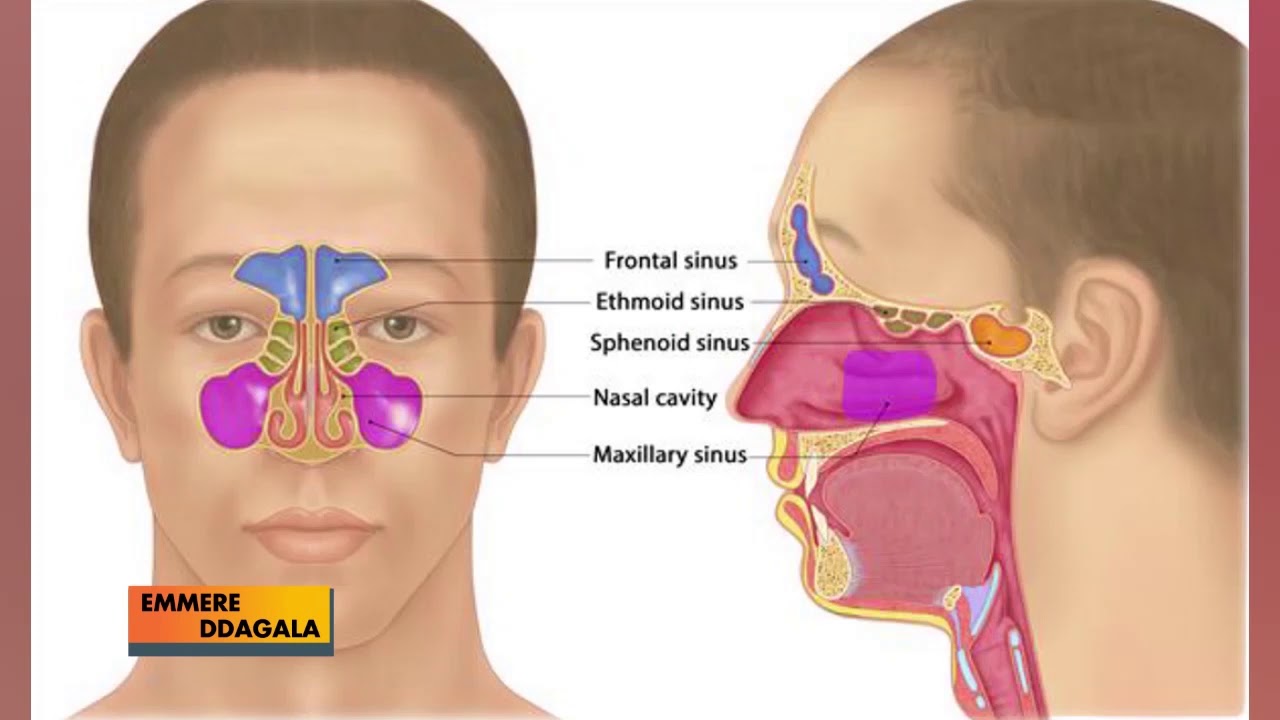 Treatment for CST typically requires antibiotics, antifungal medication and medicine to help prevent blood clots.
Treatment for CST typically requires antibiotics, antifungal medication and medicine to help prevent blood clots.
Bacterial meningitis
Bacterial meningitis is a rare complication and a medical emergency. The most common symptoms of meningitis include sudden headache with fever and a stiff neck.
Meningitis symptoms may also include:
It’s important to see a doctor right away if you suspect meningitis because the condition can be life-threatening. Prompt treatment with antibiotics is key to recovery.
When to seek emergency medical care
If you’ve been diagnosed with or suspect sinus issues that may be affecting your eyes, you may need to see a doctor right away.
Seek emergency medical care if you have:
High fever
Stiffness of the neck
Breathing difficulty
Confusion
Blurry vision or other vision changes
Eye swelling and pressure
Severe pain in or around the eyes
Swelling around one or both eyes
If in doubt about your symptoms, it’s best to seek emergency care right away to protect your overall health as well as your eye health and vision.
Eye pain. MedlinePlus. April 2022.
Sinusitis. Johns Hopkins Medicine. Accessed April 2022.
Sinus infection (sinusitis). Cleveland Clinic. June 2020.
Pain in the quiet (not red) eye. American Family Physician. July 2010.
An association between acquired epiphora and the signs and symptoms of chronic rhinosinusitis: a prospective case-control study. American Journal of Rhinology. March – April 2003.
Cluster headache. MedlinePlus. Accessed April 2022.
What’s causing eyelid swelling after my sinus infection? American Academy of Ophthalmology. September 2018.
What to do about sinusitis. Harvard Health. January 2020.
Optic nerve changes in chronic sinusitis patients: correlation with disease severity and relevant sinus location. PLOS One. July 2018.
Preseptal and orbital cellulitis. MSD Manual Professional Version. August 2021.
Cavernous sinus thrombosis. StatPearls. November 2021.
Intracranial suppurative complications of sinusitis.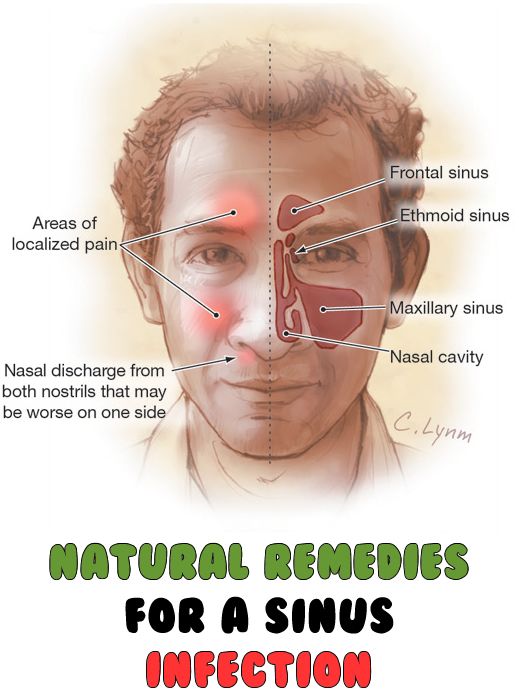 Scandinavian Journal of Surgery. February 2016.
Scandinavian Journal of Surgery. February 2016.
Bacterial meningitis. Centers for Disease Control and Prevention. July 2021.
Page published on Friday, June 3, 2022
Medically reviewed on Tuesday, April 12, 2022
Pain or Pressure Behind Your Eye? Here Are the Causes and Treatments
Categories
- News
- Industry
- Community
- Resources
- Webinars
Carefree MD
March 09, 2021 | Blog
Feeling pressure behind your eye is very uncomfortable. It’s also worrying to imagine what this symptom means. Most times, the cause of pain or pressure behind your eyes comes down to a mild illness that’s easy to treat.
But, if it’s persistent, it may be a sign of a graver problem. Find out what it could be, and what you should do when you feel pressure behind your eye.
8 Common Causes for Feeling Pressure Behind Your Eye
There’s no need to worry. These mild illnesses and conditions are very common. You can find over-the-counter treatment for your eye pressure at a local pharmacy.
1. Eye Strain
Although eye strain isn’t a medical condition, it’s a very common cause of feeling pressure behind your eye. It happens when your eyes get tired from consistent use.
Staring at a screen for most of the day, reading small print, or driving for a long period of time can cause eye strain. Some of the other symptoms of this condition are blurry vision, dry eyes, and pressure in your socket.
The best treatment for eye strain is to take a break. Let your eyes rest away from the screen, book, or windshield. Soon, the pressure behind your eyes will disappear on its own.
2. Headache or Migraine
The pressure behind your eye could come down to a simple headache or even a more serious migraine.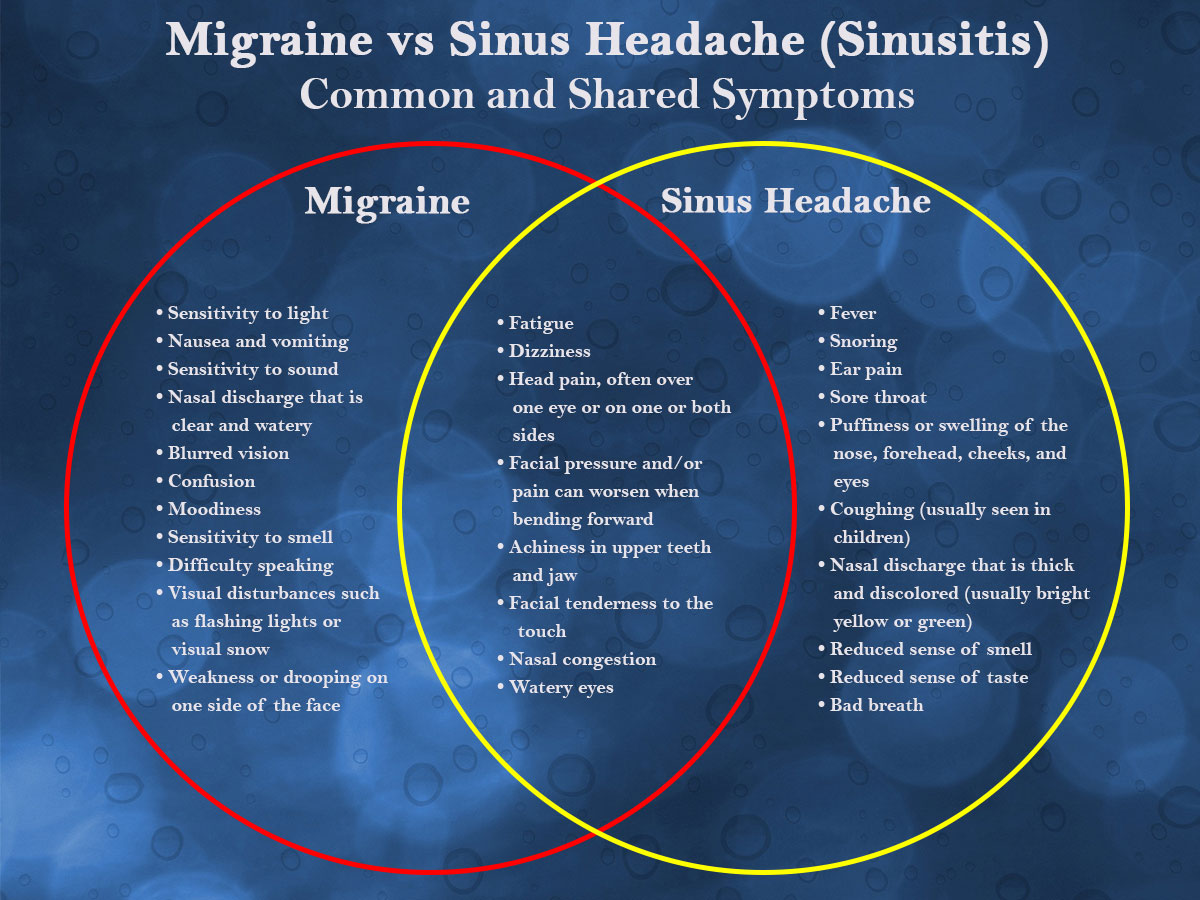
There are two types of headaches: tension and cluster. Tension headaches are consistent, they feel like wearing a tightening headband. Cluster headaches are pulsating, and they’re often accompanied by infections in the face. This infection can cause pressure behind your eye.
Migraines are periodical but consistent. You may feel pulsing pain in your head, sensitivity to light, or even nausea. Seeing flashes of light before the onset of a headache could be a sign of an oncoming migraine.
The easiest way to treat a headache is to take over-the-counter pain medication, such as ibuprofen, aspirin, or naproxen. This can reduce the pain, and relieve the pressure you feel behind your eye.
3. Sinus Infection
A sinus infection or sinusitis is perhaps the most common cause of feeling pressure behind your eyes. Your sinuses are above, below, behind, and between your eyes. When an infection fills your sinuses with mucus, it puts pressure on your eyes, nose, and cheeks from behind your face.
Other symptoms may be coughing, a stuffy or runny nose, headache, eye pain, or fever. You may also experience fatigue, a reduced sense of smell, toothache, or bad breath.
You can easily treat a sinus infection at home. Take plenty of rest, and drink a lot of fluids. Taking over-the-counter pain medication can help with the headache or eye pain. And cleaning your nose with saltwater can decongest your nose.
4. Allergies
Feeling pain behind your eyes when you’re experiencing allergic reactions happens for the same reason as sinusitis. Your sinuses become inflamed, and pressure builds up behind your face.
There are plenty of over-the-counter allergy medicines you can take to manage the symptoms. However, if your allergies are severe or consistent, you need to turn to a doctor to discuss further treatment options.
5. Grave’s Disease
Grave’s disease happens when you have an overactive thyroid. Although it has symptoms all over your body, pressure behind your eye can be a clear sign. Tissue, fat, and muscle swell behind your eye. This can cause it to bulge.
Although it has symptoms all over your body, pressure behind your eye can be a clear sign. Tissue, fat, and muscle swell behind your eye. This can cause it to bulge.
Other eye-related symptoms of Grave’s disease are irritation in the eyes, dryness, tearing up, sensitivity to light, double vision, and ulcers on the eye. But, if you notice these symptoms throughout your body, it’s worth contacting a doctor about it:
- Weight loss
- Enlarged thyroid gland
- Fatigue
- Frequent bowel movements
- Anxiety
- Rapid or irregular heartbeat
- Change in menstrual cycles
- Excessive sweating
The treatment plans for Grave’s disease most often include radioactive iodine therapy, anti-thyroid medications, beta-blockers, and surgery. The goal is to reduce your thyroids hormone production. If you suspect you have Grave’s disease, turn to a doctor immediately.
6.
 Optic Neuritis
Optic Neuritis
Optic neuritis happens when the nerves that connect your eyes to your brain get inflamed. This can cause pain or pressure behind your eye. Other symptoms include reduced or blurry vision, pain when moving eyes, and even color blindness.
The inflammation peaks within a few days. However, it can take 4-12 weeks for symptoms to improve.
Optic neuritis is commonly associated with multiple sclerosis (MS). 50% of MS patients have had optic neuritis. It’s often the first indication before an MS diagnosis.
Treatment for optic neuritis happens after a thorough medical test. This may include a routine eye exam, blood tests, ophthalmoscopy, or an MRI scan. A doctor can determine the severity of your optic neuritis to consider treatments.
7. Toothache
Even a toothache can cause pain or pressure behind your eye. When a throbbing toothache from an infection radiates pain up your face, there’s more danger than just facial pressure.
An untreated infection can spread through your muscle and tissue towards your eye. Swollen or red eyes can be a clear indicator.
A trip to the dentist can treat and alleviate your toothache, which can also relieve the pressure behind your eye.
8. Face Injury
Damage from a face injury can often cause pressure or pain around your eye socket. Fractures to the socket can damage the surrounding tissue, muscles, and nerves.
Other symptoms of a face injury can be a black eye, bulging eyes, blurry or double vision, and numbness around the eye.
Most often, you can treat a facial injury with over-the-counter medicines at home. However, if you develop a fever, loss of vision, frequent headaches, or swelling, it’s worth seeing a doctor about it. They can determine the underlying cause of your new symptoms.
Home Remedies to Relieve Pressure Behind Your Eye
Feeling pressure behind your eye is uncomfortable, no matter the cause. There are a couple of ways you can relieve the pressure at home easily.
There are a couple of ways you can relieve the pressure at home easily.
- Over-the-counter medications: Anti-inflammatories, such as ibuprofen can help reduce the pain and the inflammation that’s causing it.
- Eye drops: Very often, you need a prescription for eye drops. Ask your pharmacist what options you have. You may find over-the-counter eye drops that reduce swelling or itchiness. Do not put essential oils in your eye to relieve the pressure.
- Cold compress: Putting a cold compress on your eye can be a welcome remedy if you’re feeling heat and pain around your eye. It’s especially helpful when you’ve experienced a face injury.
- Blindfold: If you’re experiencing sensitivity to light, a blindfold or eye patch can help temporarily.
If you feel pressure behind your eye because of an infection, you may need antibiotics or antiviral medication. You can get a prescription for these from a doctor.
Talk to a Doctor About the Pressure Behind Your Eye
While the cause for the pressure behind your eye may be a mild illness, there are a range of serious illnesses that could be the underlying cause. If those conditions are left untreated, they could lead to a life-threatening situation.
If those conditions are left untreated, they could lead to a life-threatening situation.
If your eye pressure doesn’t disappear with home remedies or over-the-counter pain medication, it’s best to see a doctor. Luckily, you don’t even have to leave your house to consult with a qualified physician. Just book an appointment online.
At Carefree MD, we have doctors on call for you 24/7. You can talk to a doctor online today about headaches, sinus conditions, allergies, and a number of other issues.
All you have to do is sign up for Carefree MD. Once you’re a member, you can get unlimited access to a virtual doctor to help you with your medical needs. Learn more!
The Carefree Dental MD blog is not meant to be a substitute for professional medical advice, diagnosis, or treatment. The text and pictures within the content are intended for information purposes only. Readers should consult with a licensed doctor or healthcare professional before seeking treatment.
The Carefree MD Card is not insurance and Carefree MD is not an insurance provider.
Frontitis: symptoms, types and treatment of frontitis in adults
Author, editor and medical expert – Klimovich Elina Valerievna.
Editor and medical expert – Harutyunyan Mariam Harutyunovna.
Date last updated: 05/29/2023
Number of views: 232,973.
Average reading time: 9 min. 34 sec.
Contents:
Types of sinusitis
Symptoms of sinusitis
Causes of sinusitis
Treatment of sinusitis
Complications of frontal sinuses
Prevention of frontal sinuses
Frontitis is an inflammatory process in the mucous membrane of the frontal sinuses 1 . The frontal sinus (it is also called the “frontal sinus”) is an air cavity in the thickness of the frontal bone, which is connected with the nasal cavity by a thin convoluted canal – fistula 4 .
The term sinusitis is used to refer to inflammation of the paranasal sinuses, or sinuses. But, since the sinuses are located in different bones of the skull (maxillary, ethmoid, frontal and sphenoid), each lesion has its own name 4 .
But, since the sinuses are located in different bones of the skull (maxillary, ethmoid, frontal and sphenoid), each lesion has its own name 4 .
Our article is devoted to frontal sinusitis, its features and methods of treatment.
Types of frontitis
The disease can occur in acute and chronic form.
In acute inflammation, the mucous membrane of the frontal sinus thickens 20-100 times, and pillow-like formations appear on it, sometimes filling the entire sinus lumen 1 . “Pillows” squeeze the vessels of the mucous membrane, which causes blood stasis, and inflammatory fluid actively accumulates in the sinus cavity 4 . At the beginning of the disease, it is usually transparent or mixed with blood – this is a catarrhal form of frontal sinusitis 5 . If the process progresses, then air exchange and the outflow of inflammatory fluid through the fronto-nasal canal are disturbed, the effusion can quickly fester. In this case, purulent frontal sinusitis develops 4.5 .
In this case, purulent frontal sinusitis develops 4.5 .
If the inflammation lasts more than 1 month, the diagnosis is chronic frontal sinusitis 5 . Due to a long sluggish inflammatory process in the frontal sinus, its mucous membrane thickens and grows, and polyps or cysts can form in its lumen 4 .
Symptoms of sinusitis
Acute inflammation resembles a cold, or ARVI (acute respiratory viral infection), in which, against the background of elevated temperature (up to 38-39 ° C), complaints appear on:
- general weakness;
- malaise;
- chills 5 .
The development of frontitis with a cold is indicated by pain in the forehead on the side of the lesion, nasal congestion and clear or white-yellow discharge from it 5 .
Chronic sinusitis manifests itself in different ways, depending on the severity and nature of the inflammatory process in the frontal sinus, as well as the development of complications. The disease is characterized by persistent or recurrent headaches in the forehead of varying intensity, which can intensify if you tilt your head down. Quite typical symptoms of the chronic form are intermittent runny nose with discharge from the nose and decreased sense of smell 5 .
The disease is characterized by persistent or recurrent headaches in the forehead of varying intensity, which can intensify if you tilt your head down. Quite typical symptoms of the chronic form are intermittent runny nose with discharge from the nose and decreased sense of smell 5 .
Back to top
Causes of sinusitis
Sinusitis usually occurs when there is inflammation in the nasal cavity. Under the influence of certain factors, pathogens from the nasal cavity can penetrate through the fronto-nasal canal into the frontal sinus and cause inflammation. And if the canal itself becomes inflamed, then this can lead to narrowing of its lumen and complete blockage of the sinus outlet openings 4 .
The development of frontitis is facilitated by:
- unfavorable environmental factors (dust, harmful substances at work) 5 ;
- reduction of general and local immunity 5 ;
- presence of foci of chronic infection in the body 10 ;
- violation of the mechanism of self-cleaning of the respiratory tract 5 .

A healthy person has a mechanism of self-cleaning of the nasal cavity and sinuses – mucociliary clearance. It includes the properties of the mucus itself (mucus – mucus) and the work of the cilia of the mucous membrane (cilium – cilium): mucus traps dust and bacteria, and cilia move mucus towards the nostrils and nasopharynx (in both cases, bacteria are removed from the nasal cavity) 4 . Thanks to mucociliary clearance, the infection does not penetrate into the paranasal sinuses 4.5 .
If there is a slight swelling of the mucous membrane or a mechanical factor that narrows the nasal passages, then two opposite sections of the mucous membrane touch, the work of the cilia slows down or is completely blocked, and the mucus is not removed – this creates the conditions for the introduction of infection 5 .
Next, let’s talk about the main diseases in which mucociliary clearance is impaired.
Colds
Frontitis can accompany ARVI or develop as a complication of a cold due to the addition of bacteria 2.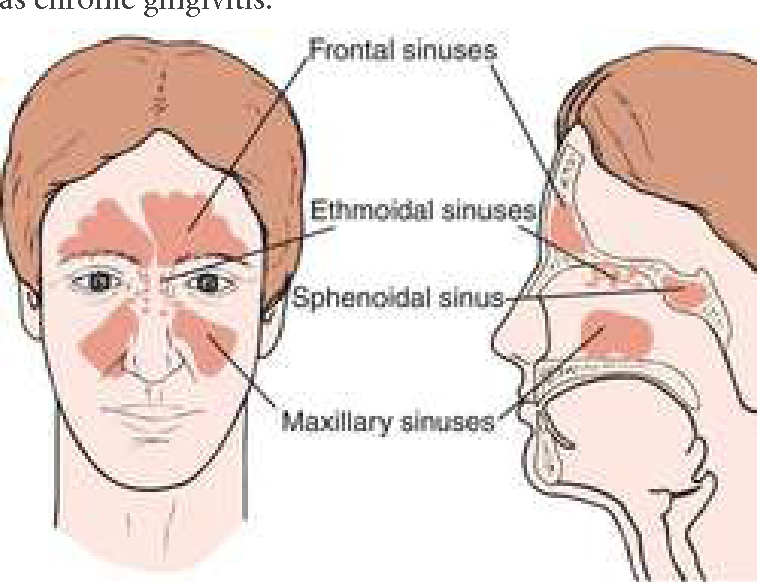 3 .
3 .
It is believed that with any inflammation of the nasal mucosa – rhinitis – the mucous membrane of the sinuses is also involved in the process, so doctors diagnose “rhinosinusitis” 3 .
Especially often the development of acute viral frontal infections occurs during influenza 4 .
Influenza virus purposefully disrupts the function of the mucosal cilia, impairing the self-cleaning process. Therefore, with the flu, the infection can easily enter the sinuses and cause inflammation in them 4 .
Acute viral rhinosinusitis does not last more than 10 days 3 , in contrast to bacterial rhinosinusitis, which can be suspected if cold symptoms – nasal congestion, headache, fever – do not stop within 10 days or recur after feeling better 2 .
Allergy
Frontitis can be a consequence of allergic rhinitis, which, like rhinitis with a cold, causes swelling of the nasal mucosa, impairing mucociliary clearance 4 .
In seasonal forms, the allergen (allergy provocateur) is usually the pollen of flowering plants, in year-round forms – components of house dust, animal hair, food or medicines 5 .
Adenoids
In the oral part of the pharynx on both sides of the tongue are palatine tonsils. They are the largest tonsils, but not the only ones: there are also small tonsils in the pharynx, at the root of the tongue and in the area of the auditory tubes 4 .
Hypertrophied (enlarged) tonsils in the nasal part of the pharynx are called adenoids4. Adenoids, increasing in size, can fill the entire space of the nasopharynx 5 , disrupting nasal breathing 4 . The overgrown tissue causes congestion in the mucous membrane of the nasal cavity and paranasal sinuses 4 , which contributes to the development of sinusitis 5 .
Deviated septum
Up to 5 years, the nasal septum is usually not deviated.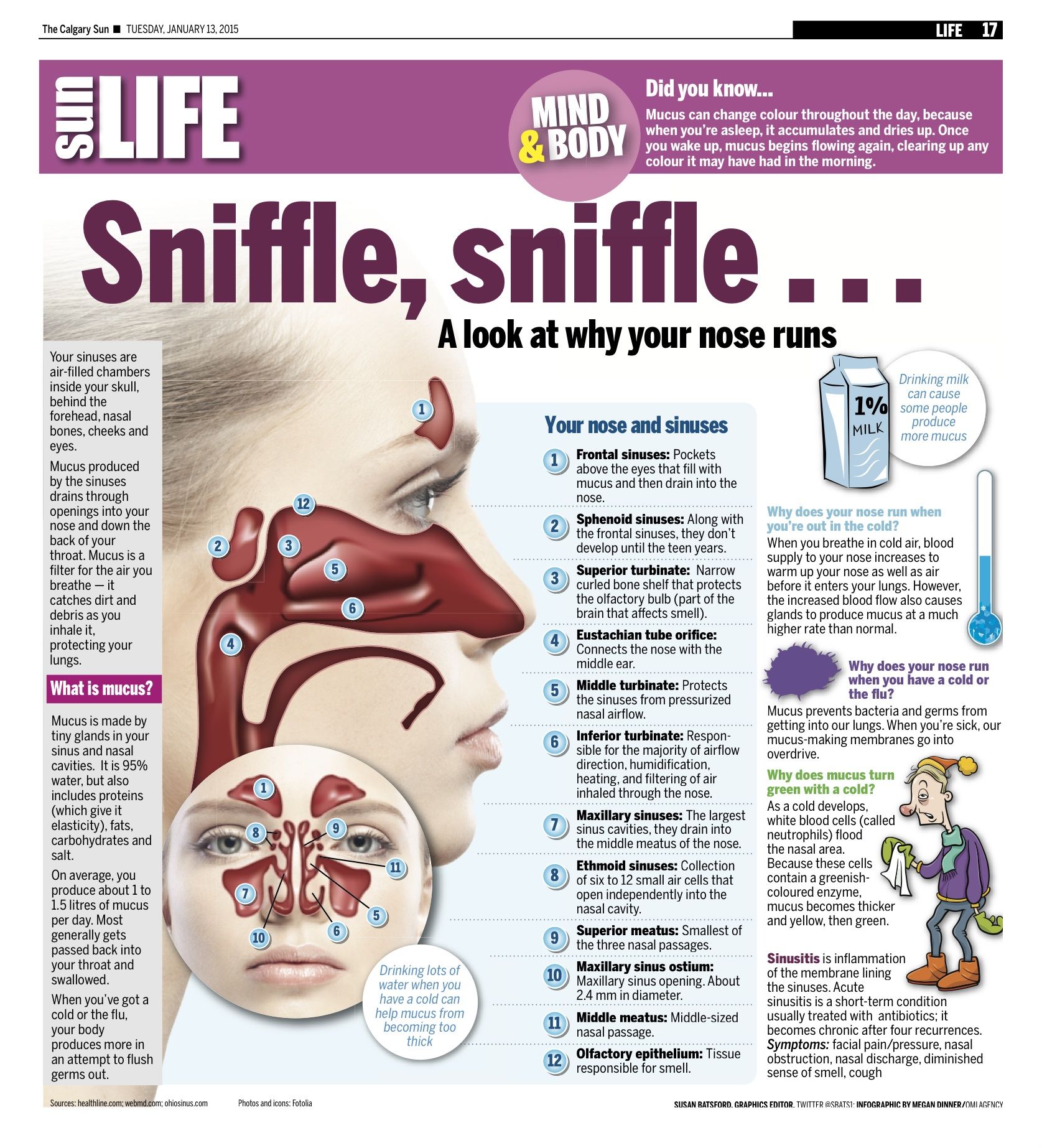 With age, due to uneven growth of the bone and cartilage sections of the nasal septum, its deviation may occur. Thus, doctors observe a curvature of the nasal septum in 95% of adult men 4 .
With age, due to uneven growth of the bone and cartilage sections of the nasal septum, its deviation may occur. Thus, doctors observe a curvature of the nasal septum in 95% of adult men 4 .
At the same time, the person complains of persistent colds and unilateral difficulty in breathing. The accumulation of mucus in one of the halves of the nose can lead to chronic inflammation of the mucous membrane of the paranasal sinuses. And then polyps can form in the nasal cavity, which aggravate congestion and often lead to frontal sinusitis 4 .
Back to top
Treatment of sinusitis
Therapy of inflammatory processes in the frontal sinuses is carried out under the strict supervision of an otorhinolaryngologist (ENT). With frontal sinusitis, treatment is primarily aimed at improving the outflow of inflammatory fluid through the fronto-nasal canal and fighting infection 5 .
The doctor may prescribe various drugs 1 :
- antiviral;
- antibacterial;
- antiallergic;
- antipyretics;
- anti-inflammatory.

Also, as part of the complex treatment of sinusitis in adults, nasal sprays of the TIZIN ® line can be used:
- TIZIN ® nasal congestion, and also improves nasal discharge 7 . The action of TIZIN ® Classic can start as early as 2 minutes after applying 7 and can last up to 10 hours 11 .
- TIZIN ® Panthenol contains not only the vasoconstrictor component xylometazoline, but also the B vitamin dexpanthenol. Dexpanthenol is converted in the body to pantothenic acid, which has a restorative and mild anti-inflammatory effect on the nasal mucosa 9 .
- A doctor may recommend the use of TIZIN ® Allergy to combat the symptoms of seasonal and year-round allergic rhinitis in adults. Its active ingredient, levocabastine, relieves the symptoms of allergic rhinitis, such as sneezing, nasal itching, and discharge from the nasal cavity. The drug can begin to act 5 minutes after application and may remain active for 12 hours 8 .

At the stage of recovery, all patients are recommended outdoor walks, vitamin therapy and breathing exercises 1 .
In chronic sinusitis, a sinus catheter is often used, which allows you to actively suck out the contents of the sinuses on the side of the lesion, wash them and administer drugs (antibiotics, enzymes, etc.) 5 .
In case of complications of sinusitis, inefficiency of medical methods of treatment and chronic inflammation with frequent exacerbations, surgery is necessary 5.10 . Surgical intervention allows the doctor to clean the contents of the frontal sinus manually, restore the patency of the channel to facilitate the outflow of fluid, and also provide conditions for washing and injecting anti-inflammatory drugs directly into the sinus 4.10 .
Complications of frontal sinusitis
If you notice symptoms of sinusitis, make an appointment with an otolaryngologist right away. It is very important to quickly eliminate the cause of the disease and begin treatment, otherwise complications may occur. In case of chronic inflammation, the process can move to neighboring structures, for example, in the region of the orbit and even the cranial cavity 5 .
In case of chronic inflammation, the process can move to neighboring structures, for example, in the region of the orbit and even the cranial cavity 5 .
Prevention of frontal sinusitis
To prevent sinusitis, first of all, it is necessary to eliminate the factors that disrupt nasal breathing – restore the nasal septum, remove adenoids, treat allergies, and most importantly, prevent the occurrence of foci of chronic infection in the body 1 .
Since frontal sinusitis is often a companion of acute colds 3 , preventive measures should be aimed at preventing infection with the main ARVI pathogens, as well as their timely and complete treatment. Consult your doctor for detailed advice and initiation of effective therapy.
The information in this article is for reference only and does not replace professional medical advice. For diagnosis and treatment, contact a qualified specialist.
Back to top
See also:
- Sinusitis
- Allergic rhinitis
- Acute sinusitis
9 0000 Maxillary sinus mucocele, removal surgery, treatment price
Maxillary sinus mucocele is a benign neoplasm. In the initial stages, it does not manifest itself in any way or is accompanied by symptoms of sinusitis, which makes it difficult to timely identify. Grows over time, exerts pressure on surrounding anatomical structures . Treatment is only surgical after careful computer diagnostics.
In the initial stages, it does not manifest itself in any way or is accompanied by symptoms of sinusitis, which makes it difficult to timely identify. Grows over time, exerts pressure on surrounding anatomical structures . Treatment is only surgical after careful computer diagnostics.
The ENT department of the Doctor Levin Center specializes in helping patients with problems of the maxillary sinuses. Over 20 years of work, surgical treatment programs have been developed for various clinical situations. Operations are performed only by maxillofacial surgeons with a deep understanding of the anatomy of the upper jaw and honed manual skills. Modern equipment of the department helps to make an accurate diagnosis, choose the optimal treatment regimen and perform surgery with high accuracy.
Causes of mucocele formation in the maxillary sinuses
Mucocele of the maxillary sinuses is a cyst-like tumor lined with epithelium and filled with mucus. Occurs rarely. It is formed as a result of blocking the opening connecting the sinus with the nasal cavity, leads to a violation of the outflow and accumulation of fluid. It grows slowly, but gradually produces mucus, increases in size and deforms the surrounding bone.
It is formed as a result of blocking the opening connecting the sinus with the nasal cavity, leads to a violation of the outflow and accumulation of fluid. It grows slowly, but gradually produces mucus, increases in size and deforms the surrounding bone.
Main causes of occurrence :
- chronic inflammation of the sinus of an infectious nature;
- maxillary sinus injury;
- allergic diseases;
- fungal sinusitis;
- previous surgeries.
Symptoms
Symptoms differ depending on the stage of development of the mucocele
Latent period
Most often the initial stage is completely asymptomatic . Rarely, nasal discharge is possible as a result of a temporary opening of the duct or a breakthrough of the contents of the mucocele. At this stage, inflammation of the neoplasm is possible. Patients report symptoms similar to those of a common ARVI or sinusitis. The nose is blocked, mucus and / or pus is secreted. Complaints about an unpleasant smell in the nose, the sense of smell worsens. Sometimes a mucocele leads to bleeding.
Complaints about an unpleasant smell in the nose, the sense of smell worsens. Sometimes a mucocele leads to bleeding.
Asymptomatic course or similarity to sinusitis does not arouse suspicion in patients, and this is the insidiousness of the disease . At the initial stage, the mucocele is most often detected by chance on a CT scan during examination of the sinuses in preparation for other operations. The disease without detection and timely treatment continues to develop and eventually goes beyond the sinus.
Beyond the sinus
When the mucocele grows, it manifests itself as pain and swelling in the face, eyes, jaw. Pathology can be manifested by paresthesia and facial asymmetry as a result of pressure on the first branch of the trigeminal nerve. Pain can radiate to the upper jaw, it is difficult to open the mouth. Mucocele can deceptively radiate to the teeth, a non-carious lesion of dental tissues develops . Sometimes the pain radiates to the gums, cyanosis is possible.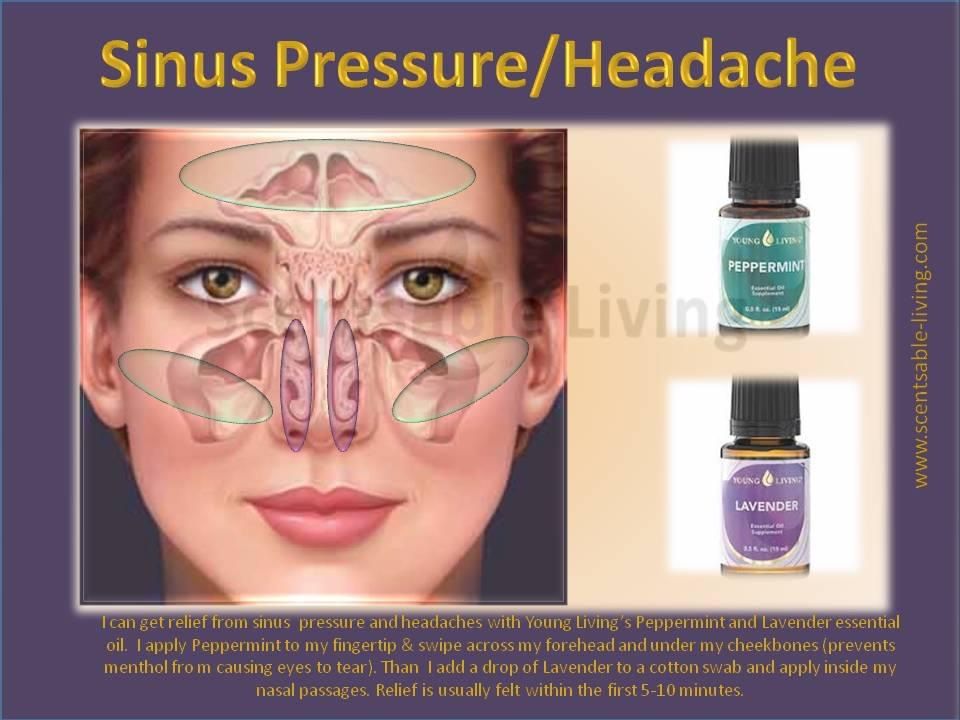
Close proximity to the eye socket causes pressure on the organs of vision and the optic nerve. The area near the inner corner of the eye swells, possibly protruding eyeballs. Patients complain of pressure from the inside on the eyes, which is accompanied by lacrimation. Vision may become cloudy, the picture doubles, in severe cases, loss of vision.
In an advanced situation, the patient suffers from a headache. Only a strong pain reliever relieves her. In parallel, there is chronic fatigue.
Why is the disease dangerous? knitted by pressure of the mucocele on anatomically important structures, as a result occurs:
Why it is worth entrusting treatment to the ENT department of dentistry
Our Center uses an integrated approach in the treatment of neoplasms of the maxillary sinuses
ENT dentistry is a combination of two areas of medicine – otolaryngology and dentistry. Allows you to combine dental and ENT treatment options.
Conventionally, patients who come to us for help can be divided into 2 categories:
- After treatment in state medical institutions.
 Most often complain of toothache and symptoms of inflammation of the maxillary sinuses. Often, such patients were underexamined, the causes of the problem were not identified, respectively, unified treatment by an ENT doctor did not bring results.
Most often complain of toothache and symptoms of inflammation of the maxillary sinuses. Often, such patients were underexamined, the causes of the problem were not identified, respectively, unified treatment by an ENT doctor did not bring results. - The problem is identified in preparation for implantation or other procedures. During a computer examination, a sinus formation is diagnosed on a 3D image, which is an obstacle to dental intervention and requires surgery to remove it.
Doctor Levin Center specializes in providing assistance with combined otolaryngological and dental pathologies. The ENT department is equipped with modern diagnostic and operating equipment for the most complex interventions. Surgical treatment programs are carried out by highly qualified maxillofacial surgeons with ENT training.
Diagnosis of mucocele
Since the disease has similar symptoms to other diseases of the maxillary sinuses, a differentiated diagnosis is made from acute or chronic sinusitis, osteotoma, cysts, polyps and other neoplasms.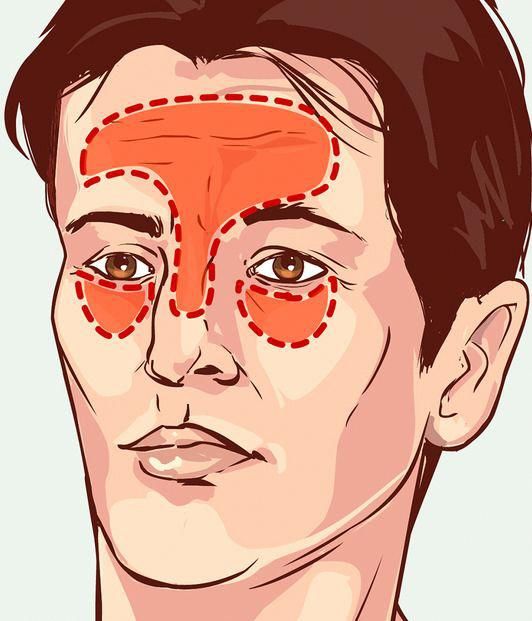
The doctor makes a diagnosis based on the patient’s complaints, visual examination, palpation with a visible manifestation of the tumor. General blood and urine tests may be required. But only computed tomography allows you to get an idea of the formation, type, stage and location as accurately as possible. Sirona Galileos 3D tomograph with ENT mode settings is used in our Center.
Only computed tomography in ENT mode allows you to assess the size of the neoplasm, its exact localization and the degree of impact on the surrounding structures
Experienced maxillofacial surgeons determine the disease by characteristic signs on the radiograph. Based on the results of diagnostic studies, the optimal method for eliminating the neoplasm is selected.
Treatment options
Treatment of mucocele is only surgical
The operation is simple , involves removal of the saccular formation, ultrasonic removal of inflamed bone tissue, revision and washing of the sinus. Depending on the size and localization of the neoplasm, the sinus access protocol is determined.
Depending on the size and localization of the neoplasm, the sinus access protocol is determined.
| Intranasal Protocol | Microsurgical protocol | Micro maxillary sinusectomy | Radical maxillary sinusectomy |
|---|---|---|---|
Access Through the nasal passage with the expansion of the natural anastomosis, using the endoscope | Access Alveolar (“CHLH-access”), i. through the hole of the extracted tooth, no later than 9 days from the date of removal | Access “ENT access”, through a 3-4 mm hole in the anterior wall of the maxillary sinus in the oral cavity | Access Lateral, in the anterior wall under the upper lip in the area of the 6th tooth, a window with a diameter of 10-15 mm is created |
Indications Simple cases: no neoplasms, localization of the foreign body allows, no contraindications | Indications Cases of moderate complexity: if the tooth is not saved, there are neoplasms, difficult localization | Indications Complex cases: removal of multiple or large neoplasms, difficult localization of foreign bodies | Indications Advanced cases: multiple neoplasms, complex localization of foreign bodies |
Injury minor | Injury low | Injury low | Injury high |
Operation duration 60 minutes | Operation duration up to 1. | Operation duration 1 to 3 hours | Operation duration 2 to 4 hours |
Cost low | Cost average | Cost average | Cost high |
The operation is performed in sedation, without pain and nerve overload
During the procedure you will not feel anything, you will not be haunted by unpleasant memories. Ultra-short-acting drugs are put into a controlled state of sleep, this is not general anesthesia . The exit from the state is easy, hospitalization is not required, after 40 minutes you can go home.
Levin Dmitry Valerievich
Chief Physician and Founder of Doctor Levin
Stages of treatment
In our Center, all procedures are performed in one day, no hospital stay is required. In one visit, we will carry out preparatory activities and the operation itself.
- Preparation
Before any operation, a hygienic cleaning of the teeth is mandatory to maintain sterile conditions in the oral cavity and to prevent the risk of infection of the operated area. - Removal
Performed in the sterile operating unit of the ENT department. Lasts about an hour in a dream. Maxillofacial acts according to the chosen protocol under the visual control of a microscope. - Control
A control computed tomography is performed to assess the quality of the operation performed – to make sure that the formation has been removed completely and to assess the general condition of the maxillary sinus.
After the gums have healed and the stitches have been removed (after 10-14 days), the patient is invited for a follow-up examination. Further, preventive examinations are prescribed after 3 months, six months, a year to control the situation.
Recovery after surgery
Without hospitalization
Since general anesthesia is not used in our Center, recovery is fast, post-narcotic complications and other troubles are excluded. There is no need to stay in the hospital for 2-3 days in a 24/7 format. Modern equipment and safe sedation devices allow you to organize a low-traumatic operation. 30-40 minutes after the end, you can return home.
For patients with cardio- and vascular diseases, the Center provides a post-operative ward. It is possible to recover within 2-3 hours under the supervision of our anesthesiologist-resuscitator.
Branded rehabilitation on the same day
Our Center has developed an original method of accelerated rehabilitation – for those who want to recover faster after surgery. A complex of procedures is carried out on the day of the operation, if necessary, repeated with a bite. Aimed at minimizing hematomas, preventing swelling and pain:
A complex of procedures is carried out on the day of the operation, if necessary, repeated with a bite. Aimed at minimizing hematomas, preventing swelling and pain:
Microcurrent Therapy
Physiotherapy treatment with low frequency currents on tissues. Weak impulses stimulate metabolism – cell nutrition is improved, regeneration is activated, pains and spasms disappear.
Facial biostimulation
D-NUCLEO biomodulators increase regenerative potential, improve lymph and blood flow. They have an anti-inflammatory effect, relieve swelling, relieve cosmetic traces of the operation.
Plasma therapy PRP
Injection procedure involving the introduction of autoplasma enriched with platelets. The reserve forces of the body are launched, due to which the production of new healthy cells is accelerated.
Home medicines
Healing occurs within a week. You will receive free of charge a complete package of necessary medicines and instructions with the rules of conduct during the rehabilitation period. Please observe the medication and follow the recommendations during the rehabilitation period in order to avoid complications.
Please observe the medication and follow the recommendations during the rehabilitation period in order to avoid complications.
The package contains the necessary medicines and instructions with recommendations in the postoperative period
Frequently Asked Questions
How to distinguish between mucocele and sinusitis?
Neoplasm usually occurs in only one of the sinuses. With the similarity of symptoms, the formation makes itself felt with neurological symptoms, as it has a mechanical and inflammatory effect on tissues and intracranial structures. An examination on a computed tomography scanner in the ENT mode helps to finally differentiate the mucocele from sinusitis.
Levin Dmitry Valerievich
Oral and maxillofacial surgeon, chief physician of the Center
What is the difference between a paranasal sinus mucocele and a cyst?
Can a mucocele recur after removal?
Can mucocele be treated with antibiotics?
In some cases, drugs can provide temporary relief, relieve symptoms of sinusitis, but do not completely eliminate the problem.





 5 hours
5 hours